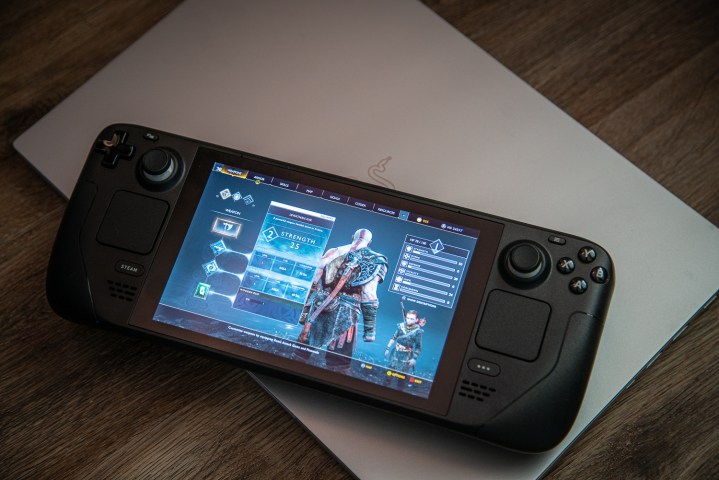Steam Deck 2: everything we know so far

It’s a matter of when we’ll see the Steam Deck 2, not if we’ll see it. Valve has talked publicly multiple times about its plans for a next-gen Steam Deck, which shouldn’t come as a surprise given that the original is easily the best handheld gaming PC you can buy.
Although the Steam Deck 2 is still a few years off, Valve has been dropping hints about the handheld for a while. Here’s everything we know about the Steam Deck 2 right now, from the possible release date to details on specs and performance.
Steam Deck 2: release date speculation

It’s going to be a few years before we see the Steam Deck 2. In an interview with CNBC and The Verge, Valve’s Pierre-Loup Griffais said, “… changing the performance level is not something we are taking lightly, and we only want to do so when there is a significant enough increase to be had. We also don’t want more performance to come at a significant cost to power efficiency and battery life. I don’t anticipate such a leap to be possible in the next couple of years.”

Get your weekly teardown of the tech behind PC gaming
Griffais said this in the context of performance targets. He added that the company wants to ensure that the gameplay experience is consistent across devices. In other words, Valve doesn’t want to move the performance goalposts for developers and players for no reason. There would need to be a chip that’s significantly more powerful than what is available today for a Steam Deck 2 to come out, Griffais said.
Adding on to that, Valve’s Lawrence Yang told Rock Paper Shotgun that “a true next-gen Deck with a significant bump in horsepower wouldn’t be for a few years.”
It’s clear Valve is thinking about the future of the Steam Deck. We recently saw the Steam Deck OLED upgrade, for instance, and these interviews show that the company is looking for a more powerful chip to power a potential Steam Deck 2.
At this point, I’d guess that a Steam Deck 2 would arrive in 2026. That’s just a guess, so don’t read into that date too much. That’s far enough out that Valve would have access to a mature system-on-a-chip (SoC) that’s far more powerful than what we have today, and it lines up with the “few more years” claim we’ve heard from Griffais and Yang.
More recently, Yang and Valve’s Yazan Aldehayyat doubled down on the release timeline, saying that company isn’t “going to do a dump every year.” Yang continued, “From our perspective, that’s kind of not really fair to your customers to come out with something so soon that’s only incrementally better… we’re waiting for a generational leap in compute without sacrificing battery life.”
Steam Deck 2: pricing

I doubt the Steam Deck 2 will cost $400 like the original. Valve’s Gabe Newall described hitting $400 for the original Steam Deck as “painful” in an interview with IGN. Given what we’ve seen from competitors like the ROG Ally and Legion Go, the price bracket for a handheld gaming PC is much higher — typically between $600 and $800.
Valve learned this lesson, too. In speaking to Edge magazine, Newall said: “We thought the entry price was going to be the critical factor [for the Steam Deck’s success], but it turns out that far and away the most popular SKU is the most expensive one. That’s an example of us being a little surprised by what our customers are telling us … it helps frame our thinking for Steam Deck 2.”
We saw Valve’s pivot on pricing in action with the release of the Steam Deck OLED. Instead of a stripped-down budget version, Valve settled on a 512GB model for $550 and a 1TB model for $650. It maintained the $400 price point with an older LCD version, but for the new OLED models, Valve moved the minimum price up.
I suspect Valve will do something similar with the Steam Deck 2. It will likely move one of the OLED models down to maintain that $400 price point while selling the new versions between $500 and $700.
Right now, however, that’s just speculation. Pricing conditions could change in a few years when the Steam Deck 2 is more likely to show up, so we’ll just have to wait until Valve has more to share.
Steam Deck 2: specs

At this point, it’s hard to say what the specs of the Steam Deck 2 will be. There’s a good chance Valve itself doesn’t know yet. Rumors point to an updated Steam Deck using another custom APU from AMD, similar to the original version. Online speculation says this chip will use AMD’s RDNA 4 graphics architecture — an as of yet unreleased GPU architecture that will power next-gen AMD desktop GPUs — and the Zen 4 CPU architecture.
This is, well, speculation, and mostly built on the back of a vague post on the Chiphell forums. Previously, a lot of the focus was on Valve’s Sephiroth APU, which is a follow-up to the Aerith APU featured in the original Steam Deck. The Sephiroth APU turned out to be the chip inside the Steam Deck OLED. It uses a more efficient manufacturing process and comes with extra goodies like Wi-Fi 6E, but it’s not a generational leap.
We’ll likely have a good idea of what the APU will look like prior to the Steam Deck 2’s release. Valve doesn’t manufacture a lot of chips, after all, and the dedicated miners digging through Linux updates and driver commits will likely find something when Valve is nearing the launch of the Steam Deck 2.
For my part, I suspect Valve will stick with AMD for a next-gen Steam Deck, as AMD has a robust foundation for semi-custom chips in gaming devices — just look at the PlayStation 5 and Xbox Series X. However, Intel has recently started building its own chips for devices like the MSI Claw, and rumor has it that Nvidia is eyeing the market, as well. Valve could go with a different chip depending on what’s available when the Steam Deck 2 gets closer.
Steam Deck 2: performance

Without any solid specs to go on, it’s a fool’s errand trying to try and nail down how the Steam Deck 2 will perform. I’m confident in saying it will be significantly faster than the original Steam Deck. That’s because Valve has gone on the record saying that’s a target for Steam Deck 2.
The Steam Deck 2 will be much faster, but peak performance likely isn’t the primary concern. The Steam Deck doesn’t have the battery life of a Nintendo Switch, but it’s leagues ahead of something like the Asus ROG Ally, so that and power effeiciency are clearly a focus for Valve.
Assuming Valve goes with an APU that uses the RDNA 4 graphics architecture and Zen 4 CPU architecture, there would be a big boost to ray tracing. AMD’s RDNA 2 architecture, which is in the current Steam Deck, is notoriously weak when it comes to hardware-accelerated ray tracing. Even then, the Steam Deck still supports some light ray tracing in games like Doom Eternal. A next-gen version would likely have far greater ray tracing prowess.

The more exciting developments will likely happen on the software front, however. As stable as the Steam Deck is today, the software is still very much a work in progress with translation layers like DXVK. By the time the Steam Deck 2 rolls around, I suspect a significant development will be just how far running Windows games on Linux has progressed.
In addition, we have some exciting performance-boosting features now that weren’t available to the original Steam Deck. AMD’s FSR 3 comes to mind, and it has huge implications for a device like the Steam Deck with its frame generation capabilities. A device-level frame interpolation feature could be a game changer for the Steam Deck 2.
Steam Deck 2: display

We saw with the Steam Deck OLED just how important the display is for a handheld gaming PC. Valve will likely focus a lot of attention on the screen for a next-gen Steam Deck, but it’s still not clear how the final product will look.
The aforementioned Chiphell rumor says that Valve will go with a 900p OLED display with a refresh rate of 90Hz. That’s very similar to what the Steam Deck OLED has, though with a minor bump to resolution. I would hope that Valve is a little more ambitious with the display on a next-gen Steam Deck.
What could that look like? Well, it will most certainly be OLED. The screen on the Steam Deck OLED is truly a transformative component, and I can’t imagine Valve will ditch the tech for its next-gen version. We’ll likely see a bump in resolution and refresh rate as well, depending on what the device is capable of.
It’s that last bit that’s most important. With both the Steam Deck and Steam Deck OLED, Valve proved that it wants to match the display to the capabilities of the device. I don’t suspect some absurd resolution or refresh rate like we see on the Lenovo Legion Go.
#Steam #Deck
